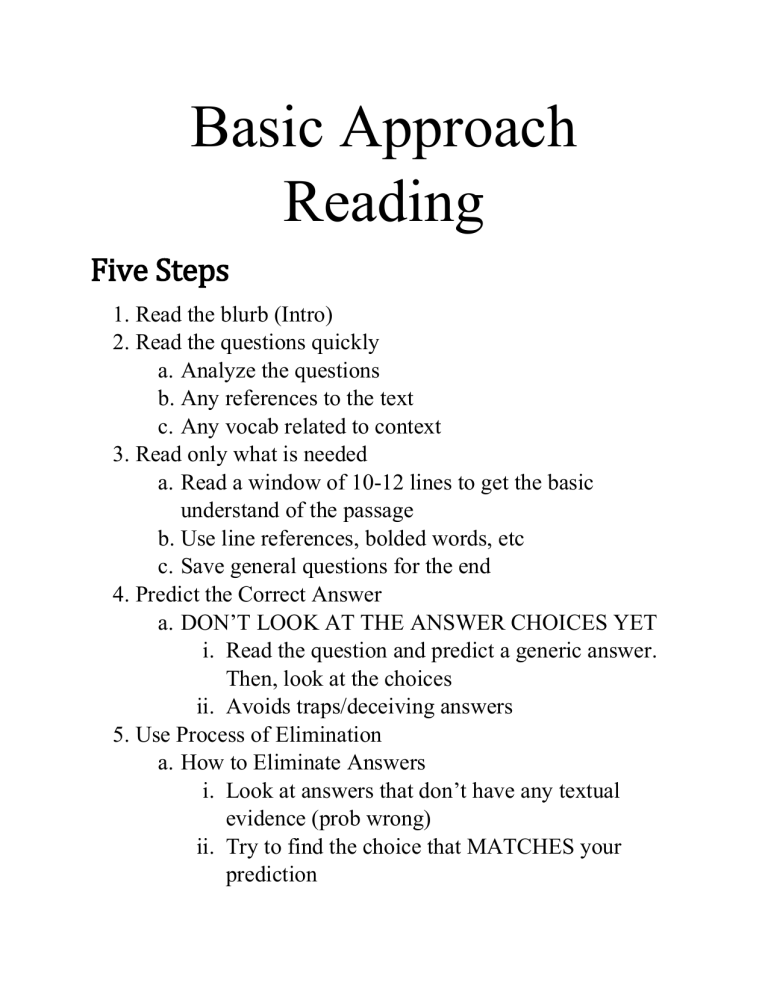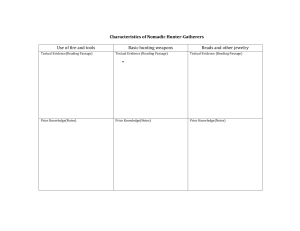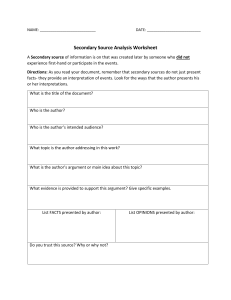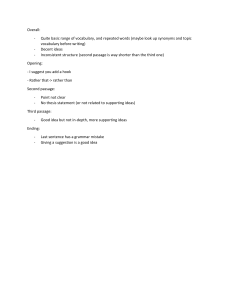
Basic Approach Reading Five Steps 1. Read the blurb (Intro) 2. Read the questions quickly a. Analyze the questions b. Any references to the text c. Any vocab related to context 3. Read only what is needed a. Read a window of 10-12 lines to get the basic understand of the passage b. Use line references, bolded words, etc c. Save general questions for the end 4. Predict the Correct Answer a. DON’T LOOK AT THE ANSWER CHOICES YET i. Read the question and predict a generic answer. Then, look at the choices ii. Avoids traps/deceiving answers 5. Use Process of Elimination a. How to Eliminate Answers i. Look at answers that don’t have any textual evidence (prob wrong) ii. Try to find the choice that MATCHES your prediction iii. Answers that seem mostly right but are also slightly wrong are prob wrong iv. Deceptive language 6. Remember: MAKE SURE TO CHECK IF THE ANSWER CHOICE MATCHES YOUR ORIGINAL PREDICTION!! The Importance of Text The text ALWAYS matters o All questions will have textual evidence, even if it seems like it is asking an inference question Ex: Author’s attitude, tone, theme, etc For Vocab o Use context clues to find the answer o Read phrases before and after word to help find the answer Paired Questions Questions that ask you to match textual evidence with the previous question o Think about the second question as the “why” to the first question. o Read the text carefully – what does it EXACTLY say about the first question Parallel POE o Sometimes, analyze BOTH paired questions at the same time to help find the answer o Eliminate unclear connections between two choices General questions Read the text carefully and reread if needed It seems overwhelming at the beginning, but answering the specific questions helps to answer the general ones Specific questions BEFORE general questions Basic Approach Drill 1. 2. 3. 4. 5. 6. 7. 8. 9. 10. 11. Basic Approach Practice Passage One 1. C 2. B 3. A 4. D 5. B 6. A 7. B 8. C 9. D 10. C Passage two 11. A 12. C 13. B 14. A 15. D 16. D 17. A 18. C 19. B 20. B 21. C Passage three 22. B 23. B 24. A 25. C 26. D 27. D 28. A 29. B 30. C 31. B Passage four 32. B 33. A 34. B 35. C 36. D 37. B 38. D 39. C 40. A 41. C Passage Five 42. A 43. C 44. B 45. D 46. A 47. B 48. C 49. D 50. D 51. B 52. B





